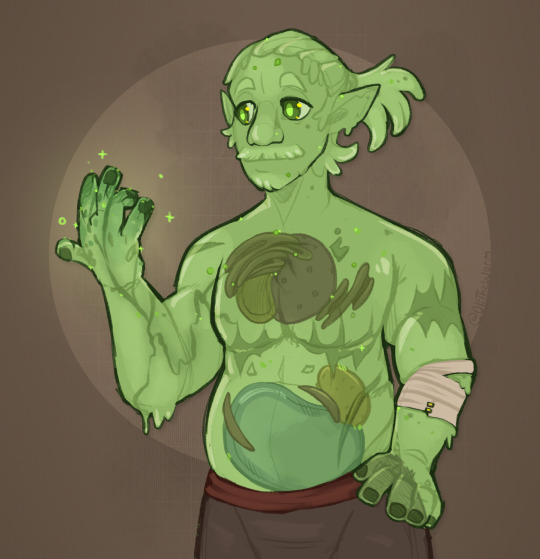#dr slime the amoeboid
Explore tagged Tumblr posts
Text

Cells, cells they're made of organelles🦠
Oh boy. This is the most self indulgent post ever. Anyway. Say hello to Acytos. He's my green cellular guy who can use a lil magic. He's just a really big cell.
Didn't expect to make a ref sheet UNTIL I realized I didn't have a good reference image for Art Fight. So here we are. I regret nothing.
#not a furry#but im not sorry behold my oc#art#digital art#digital drawing#digital artist#oc#ttrpg#ttrpg oc#ttrpg character#dr slime the amoeboid#cell oc
39 notes
·
View notes
Text

Various amoeboids. I'm kissing them all on the forehead.
#acytos the amoeboid#art#sketch page of my little guys who are normal sized actually#dr slime the amoeboid
0 notes
Text
TAFAKKUR: Part 183
From Mexican Jumping Beans to Cyborg Plants
According to Merriam Webster, cybernetics is the science of communication and control theory that is particularly concerned with the comparative study of automatic control systems, such as the nervous system, brain and mechanical-electrical communication systems). The root of cybernetics comes from Greek word “kybernētēs,” which means pilot or governor (from kybernan, which means to steer or govern). A cyborg is a cybernetic organism with both organic and cybernetic parts. We are very familiar with this term due to captivating stories of cyborgs in science fiction movies and books. Darth Vader, Robocop, Terminator, Inspector Gadget, and The Six Million Dollar Man are some of the most famous fictional cyborgs. However, cyborgs can also be plants and are not as well-known as the fictional characters on television.
In recent years scientists have taken huge steps towards the bio-hybrid architecture developed for exploring an alternate approach to the control of autonomous robots. The plant-robot interactions through cyborg plants have been investigated in an effort to apply lessons from plants to robots, which provided another role for these organisms other than being a food source or decoration items. There are several joint experimental, numerical and robotic studies conducted in this newly developed area. One of the examples includes a flower robot made by Korean engineers which has the appearance of a common flower with petals, stem and leaves. The flower robot has sensing ability, moving mechanism, and home appliance function. It can recognize environmental conditions such as room temperature, pressure, voice and light intensity and can imitate the blooming of a flower, the bending of the stem and the stirring of the leaves in the wind. Other than these, the flower robot functions as a humidifier, a vision/voice recording system and an illumination device. For example, when flower robot receives light, it senses the intensity of the light and blooms. On the contrary, when it is dark, as the flower robot starts fading away and its illumination device turns on to flash the room.
Plantas nomadas, made by Mexican artist Gilberto Espaza, is another example of cyborg plants. It uses dirty water to live. It is a miniature eco-system consisting of plants and micro-organisms within a robotic shell. Each of the components symbiotically relies on the others: the plant provides the perfect environment for the microbe, and the microbe (in a microbial fuel cell) transforms nutrients in dirty water into energy to power the robotic components, and the robotic components provide mobility.
A team from Switzerland has been working on a project that endows a robot with the ability to react in response to environmental stress of a plant in order to maintain the state of the plant. The robotic devices monitor the changes in morphology and electrical activity of the avocado plants. According to these parameters, it classifies the drought level and triggers irrigation when necessary.
Some of the artists like James Stone, who is a Media Artist specializing in digital technologies and fabrication, are interested in seeing if plants are prone to act in certain ways, show preference and possibly display other traits such as emotion. Artists are specifically curious as to what would happen when a plant is augmented with technology but also given full control over such technology to do with it whatever it chooses. To see the results of such systems that provides a means for the plant to interact with people or things will surely be fascinating. A study in this line of research is done by a group of researchers in mobile robotics at ETH Zürich, whose long-term research goal is also to bestow machines with the ability to gain and employ knowledge from the universe to improve their intelligence, by building a prototype called iRobot Create. This cyborg plant consists of a computer running Linux, a normal plant and additional sensors and lives its own life, following its internal needs of water, sunlight and electrical energy. The cyborg stays away from obstacles using ultrasonic sensors, finds the best light spot using light sensors and goes to a recharge and to a mock-up water station using iRobot's infrared sensor. Moreover, its sensors pick up noise caused by people moving around nearby, allowing cyborg plant to react by moving out of the way, to prevent themselves from getting underfoot.
It is very important to improve the ability of robots to work successfully in a complex and harsh environment, which would increase their usages. In one of those efforts exploring the use of biological systems to control robots under changing environmental conditions, Dr. David Hu and his group from Georgia Institute of Technology used the Mexican jumping bean, Laspeyresia saltitans, which consists of an empty seed housing a moth larva. Heating by the sun stimulates movements by the larva which rolls, jumps and flips by the bean. They explored this unique means of rolling locomotion and recorded bean trajectories across a series of terrain types, including one-dimensional channels and planar surfaces of varying inclination by Time-lapse videography. They found that the shell encumbers the larva's locomotion, decreasing its speed on flat surfaces by three-fold. Interestingly, they also showed that the two-dimensional search algorithm of the bean resembles the run-and-tumble search of bacteria. When they tested this search algorithm using both an agent-based simulation and a wheeled Scribbler robot, they demonstrated that the algorithm succeeds in propelling the robot away from regions of high temperature. It is amazing that from a study that involves a plant seed, a moth larva and a robot, scientists may develop applications in biomimetic micro-scale navigation systems.
The hi-tech devices that have been inspired by biological systems are not limited by the ones stimulated with plants. The insect world also represents a huge and original database for future bio-inspired systems, vehicles, and micro-vehicles . For example, the process of motion detection system in the fly’s eye is a good example of a neural circuit that was used for robot automatic piloting. Recently, a novel bat-like unmanned aerial vehicle inspired by the morphing-wing mechanism of bats has been presented. Other than that, body undulation used by snakes and the physical structure of the body of a snake may offer major advantages over typical legged or wheeled locomotion designs in certain types of scenarios, therefore a large number of research groups have developed snake-inspired robots to make use of these benefits (11). Caenorhabditis elegans, a roundworm which has similar motions with snakes but with a simpler structure, was also selected to develop a small crawling robot with a thermal shape memory alloy, a homogeneous mixture or solid solution of two or more metal, as an actuator (a type of motor for moving or controlling a mechanism or system) due to the similarities of its properties to C. elegans muscles.
Not only multicellular organisms but also unicellular (single-celled) organisms are utilized for generating cyborgs; for example, scientists used circuits prepared from Physarum polycephalum, amoeboid plasmodia of the slime mold, to control an omni-directional hexapod robot. Sensory signals from the macro-physical environment of the robot are transduced to cellular scale and processed using the unique micro-physical characteristics of intracellular information processing and the response from the cellular computation is amplified to yield a macroscopic output action in the environment mediated through the robot’s actuators.
In addition, a new biorobotic system using human neuroblastoma cultures was introduced in 2011 by a Spanish engineering group. Multielectrode Arrays Setups have been designed for direct culturing neural cells over silicon or glass substrates. The main objective of this work is to run a robot using this biological neuroprocessor and the final system could be used for many things such as testing how chemicals influence the behavior of the robot.
In summary, manipulation of robots that use living organisms as an interface to perceive the environment and transfer their responses into functions seem to have endless applications as well as challenges. Biologically-inspired technologies represent an emerging and promising field of interdisciplinary areas composed of engineering, computer sciences, chemistry, biology, physics and even art. In nature there are so many living and non-living elements designed by God to help us develop and improve robots to make our lives easier, better and more productive. Even a flower can offer us with something more than color and scent, and that is if we start thinking outside the box like so many people mentioned above have done.
#allah#god#prophet#Muhammad#quran#ayah#islam#muslim#muslimah#hadith#sunnah#revert#convert#help#religion#reminder#hijab#dua#salah#pray#prayer#welcome to islam#how to convert to islam#new convert#new revert#new muslim#revert help#convert help#islam help#muslim help
1 note
·
View note
Text

More amoeba man from me, yet again🦠✨️
My new comfort zone for drawing humanoids is him, but I'm having fun >:^]
33 notes
·
View notes
Text

Staff of Healing🦠⚡️ -- Dr. Slime has obtained a new item and has experienced the dangers.
#art#digital art#digital drawing#digital artist#oc#dr slime the amoeboid#ttrpg art#ttrpg character#ttrpg oc#ttrpg
29 notes
·
View notes
Text

Exploring the Surface🦠🌲 -- Personal piece of my oc Acytos. Had a really strong pull to draw him walking through the woods, exploring.
For the unaware, he is a giant, sentient amoeba who eventually figures out he can do magic.
#dr slime the amoeboid#ttrpg#ttrpg oc#ttrpg art#art#digital art#digital drawing#digital artist#oc#amoeba#not a furry#olitheworm
19 notes
·
View notes
Text

I cannot contain him any longer. He has breached his home colony's cavern and is out and about. --🦠✨️
Here is Doctor Slime, my table top dice rolling game character (Whitehack system). He is an amoeboid. Do not be fooled by his name, he is only distantly related to slimes. And do not think for a second that his magic is what makes him a doctor... no. He heals with the power of 11 intelligence and an advantage roll to bind your wounds when you get knocked out. His magic is highly corrosive and upsetting. Chaotic even.
This is not the last you'll see of him or.. his backstory because I cannot stop developing it.
27 notes
·
View notes
Text

The Cost of Arcane Gifts🦠⚡️ -- Some Doctor Slime development! And also, you can finally see that he is actually an abnormally sized green single cell guy.
In the game system we are using, magic costs HP to cast. And considering Dr. Slime has magic attacks like "Digestive Enzyme" and "Ooze Step" the party decided "wow its almost like he uses his physical body to cast magic" and here we are.
33 notes
·
View notes